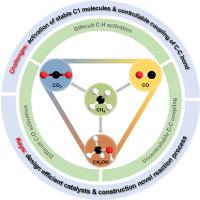EnergyChem ( IF 22.2 ) Pub Date : 2020-12-16 , DOI: 10.1016/j.enchem.2020.100050 Xiaoju Cui , Rui Huang , Dehui Deng

|
C1 catalysis based on the transformation of methane, carbon monoxide, methanol and carbon dioxide offers great potential for the sustainable production of fuels and chemicals in response to the decrease of the energy consumption and plant maintenance. While the relatively inert nature of C H and C
H and C O bond (e.g., methane and carbon dioxide) and uncontrollable coupling of C
O bond (e.g., methane and carbon dioxide) and uncontrollable coupling of C C bond render the selective activation and controllable transformation of C1 molecules to high-value-added products challenging in C1 chemistry. Catalytic conversion of C1 energy molecules under mild conditions enables a better control of the selectivity of the desired products, however, which requires highly active catalysts to lower the reaction energy barriers. Besides designing efficient catalysts to promote C1 molecules conversion, employing electro-catalysis and photo-catalysis to circumvent the thermodynamic limitations is regarded as promising ways for C1 catalysis at low temperatures. Benefiting from the advanced technology for catalyst synthesis, reactor design, mechanism understanding, catalytic conversion of C1 molecules under mild conditions has made significant progress from 2010 to 2020. In this review, we summarized the typical catalytic processes and representative catalysts for transforming methane, carbon monoxide, methanol and carbon dioxide into high value-added chemicals with a reaction temperatures below 200 °C driven by thermo-catalysis, electro-catalysis, and photo-catalysis. Besides, a short perspective is offered to highlight possible future research directions towards C1 molecules conversion under mild conditions. It is expected to provide a useful reference for the readers to design better catalysts and reaction process for mild conversion of C1 molecules efficiently in future.
C bond render the selective activation and controllable transformation of C1 molecules to high-value-added products challenging in C1 chemistry. Catalytic conversion of C1 energy molecules under mild conditions enables a better control of the selectivity of the desired products, however, which requires highly active catalysts to lower the reaction energy barriers. Besides designing efficient catalysts to promote C1 molecules conversion, employing electro-catalysis and photo-catalysis to circumvent the thermodynamic limitations is regarded as promising ways for C1 catalysis at low temperatures. Benefiting from the advanced technology for catalyst synthesis, reactor design, mechanism understanding, catalytic conversion of C1 molecules under mild conditions has made significant progress from 2010 to 2020. In this review, we summarized the typical catalytic processes and representative catalysts for transforming methane, carbon monoxide, methanol and carbon dioxide into high value-added chemicals with a reaction temperatures below 200 °C driven by thermo-catalysis, electro-catalysis, and photo-catalysis. Besides, a short perspective is offered to highlight possible future research directions towards C1 molecules conversion under mild conditions. It is expected to provide a useful reference for the readers to design better catalysts and reaction process for mild conversion of C1 molecules efficiently in future.
中文翻译:

温和条件下C1分子的催化转化
基于甲烷,一氧化碳,甲醇和二氧化碳转化的C1催化为减少能源消耗和工厂维护提供了可持续发展燃料和化学品的巨大潜力。C  H和C
H和C  O键的相对惰性(例如,甲烷和二氧化碳)和C的不可控偶合
O键的相对惰性(例如,甲烷和二氧化碳)和C的不可控偶合 C键使C1分子选择性活化和可控转化为高附加值产品,对C1化学具有挑战性。C1能量分子在温和条件下的催化转化能够更好地控制所需产物的选择性,但是,这需要高活性催化剂来降低反应能垒。除了设计有效的催化剂来促进C1分子转化外,采用电催化和光催化来规避热力学限制还被认为是低温下C1催化的有前途的方法。得益于先进的催化剂合成技术,反应器设计,机理理解,C1分子在温和条件下的催化转化,从2010年到2020年取得了重大进展。我们总结了通过热催化,电催化和光催化将甲烷,一氧化碳,甲醇和二氧化碳转化为反应温度低于200°C的高附加值化学物质的典型催化过程和代表性催化剂。此外,提供了一个简短的观点来突出在温和条件下对C1分子转化的未来可能的研究方向。有望为读者设计出更好的催化剂和反应方法,以在将来有效地实现C1分子的温和转化提供有用的参考。此外,提供了一个简短的观点,以突出在温和条件下对C1分子转化的未来可能的研究方向。有望为读者设计出更好的催化剂和反应方法,以在将来有效地实现C1分子的温和转化提供有用的参考。此外,提供了一个简短的观点来突出在温和条件下对C1分子转化的未来可能的研究方向。有望为读者设计出更好的催化剂和反应方法,以在将来有效地实现C1分子的温和转化提供有用的参考。
C键使C1分子选择性活化和可控转化为高附加值产品,对C1化学具有挑战性。C1能量分子在温和条件下的催化转化能够更好地控制所需产物的选择性,但是,这需要高活性催化剂来降低反应能垒。除了设计有效的催化剂来促进C1分子转化外,采用电催化和光催化来规避热力学限制还被认为是低温下C1催化的有前途的方法。得益于先进的催化剂合成技术,反应器设计,机理理解,C1分子在温和条件下的催化转化,从2010年到2020年取得了重大进展。我们总结了通过热催化,电催化和光催化将甲烷,一氧化碳,甲醇和二氧化碳转化为反应温度低于200°C的高附加值化学物质的典型催化过程和代表性催化剂。此外,提供了一个简短的观点来突出在温和条件下对C1分子转化的未来可能的研究方向。有望为读者设计出更好的催化剂和反应方法,以在将来有效地实现C1分子的温和转化提供有用的参考。此外,提供了一个简短的观点,以突出在温和条件下对C1分子转化的未来可能的研究方向。有望为读者设计出更好的催化剂和反应方法,以在将来有效地实现C1分子的温和转化提供有用的参考。此外,提供了一个简短的观点来突出在温和条件下对C1分子转化的未来可能的研究方向。有望为读者设计出更好的催化剂和反应方法,以在将来有效地实现C1分子的温和转化提供有用的参考。











































 京公网安备 11010802027423号
京公网安备 11010802027423号